|
|
|
|
|
|
|
Childhood in Germany
|
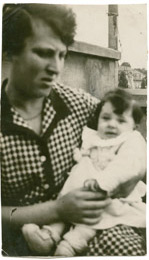 Hannelore at 9 months, March 1927
|
|
/ 1926-1932 /
Hannelore Baron (née Hannelore Alexander) is born on June 8, 1926, in Dillingen, a small town in the Saarland region of Germany. The first of Julius and Frieda Alexander’s two children, she is delivered by her uncle Siegfried, a general family doctor. Her father Julius, thirty-six years old at the time of her birth, is a fabric and textile merchant with a small shop. Within several years regulations will be passed forbidding any Jew from being the proprietor of a store, and Julius will have to conduct his business as a traveling salesman, bringing his fabric samples from house to house by bicycle. Hannelore’s mother, Frieda (née Lichtenstein), takes care of the family’s home at 9 Hüttenwerkstrasse, Dillingen.
January 19, 1928, Hannelore’s brother Hans is born. In 1932, Hannelore begins elementary school in Dillingen.
|
|
|
|
/ 1933 /
January 30, Adolph Hitler is appointed Chancellor of Germany. February 27, the Reichstag building burns, and Nazis claim that this is the beginning of a Communist revolution. February 28, emergency powers are granted to Hitler as a result of the Reichstag fire. March 22, Nazis open the Dachau concentration camp near Munich. March 24, German Parliament passes the Enabling Act giving Hitler dictatorial powers. May 10, book burnings are organized throughout Germany, primarily by university students. The German-speaking authors whose works are burnt include some of the leading authors and artists of the twentieth century including Walter Benjamin, Bertolt Brecht, Albert Einstein, Sigmund Freud, George Grosz, Heinrich Heine, Franz Kafka, Georg Lukács, Joseph Roth, Nelly Sachs and Felix Salten.
Political montage artist John Heartfield’s apartment in Berlin is broken into by the S.S. He has to leap out a window to avoid arrest and manages to take refuge in Czechoslovakia. Eventually he emigrates to England.
|
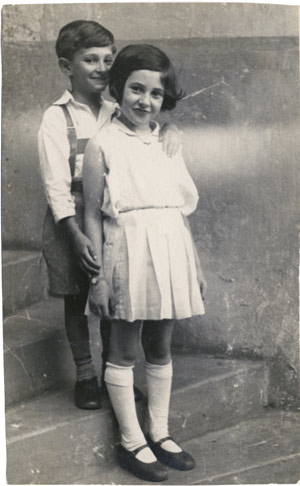 Hannelore and Hans, 1933
|
|
/ 1936-1937 /
In 1936, Jewish children are expelled from the local school, and Hannelore and her brother must attend a special school for Jewish children in Saarbrucken.
January 2, 1937, Kurt Schwitters, the master of modern collage, flees Germany and moves to Lysaker, near Oslo. Like Heartfield, he joins a massive European cultural diaspora. Other displaced artists include Laszlo Moholy-Nagy, Andre Kertesz, George Grosz, Hans Richter, Max Beckmann, Hans Hoffman and Saul Steinberg, all of whom come to the United States. A younger generation of immigrants, including Baron, painter Hannelore Wolf, and sculptor Eva Hesse, later develop artistic careers in New York.
|
| |
|
/ 1938 /
March 13, Germany annexes Austria.
July 6, Nazis prohibit Jews from trading and providing certain specified commercial services. September 27, Jews are prohibited from all legal practices. October 5, by law all Jewish passports must be stamped with a red “J.” On the night of November 9, (known as Kristallnacht, the Night of Broken Glass), German citizens, responding to a national campaign, break into Jewish homes and businesses. Jewish homes and shops are looted, synagogues and Jewish community centers are burned, and ninety-seven Jews are murdered by mobs. Following Kristallnacht, the Nazis round up approximately 30,000 German Jews and incarcerate them in various concentration camps. At this point it is still possible for inmates to arrange to be freed from the camps by showing proof that they have the necessary documents to leave Germany and will emigrate within a few weeks.
During Kristalnacht, Hannelore witnesses the destruction of her home and the beating of her father with a hammer. Her family, afraid that the mob will return, hides in the attic. Later that same night police come to the Alexander home and take her father into custody. A short time later Julius is imprisoned in Dachau.
Dillingen police tell the town’s Jews that they should illegally cross the border into France, by foot, on a designated night. On that night, Frieda takes Hannelore and her brother and joins the group. When the group arrives at the border, they find the same police officers who have instructed them to cross waiting for them. All are arrested. Hannelore’s mother is jailed in Saarlouie. Hannelore and her brother are sent to stay with the last remaining Jewish family in Dillingen. Hannelore and her brother are separated from their parents for approximately six weeks.
In late November, Hannelore is allowed to re-enter her family’s home, accompanied by an S.S. officer, to get a winter coat. She later remarks that returning to the house and seeing the destroyed furniture and her father’s bloody hand prints on the walls is more traumatic for her than witnessing the actual events of the night of November 9.
In late December, Hannelore’s parents manage to buy counterfeit Greek visas on the black market, and by showing the visas and promising a quick emigration, both parents are released.
|
| |
|
/ 1939 /
In January, Hannelore’s parents arrange for Hannelore and her brother to cross the border into Luxembourg and live with an aunt. The aunt then decides to have the children cross the border into France and live with relatives in Briey. Because the children are enrolled in school in Briey, eventually it is discovered that they have entered France illegally, and they are sent back to Luxembourg.
April 22, Baron’s parents arrive in Luxembourg, and the family is reunited.
September 1, Germany invades Poland.
|
| |
|
/ 1940 /
May 10, Germany invades Luxembourg, The Netherlands and Belgium. Luxemburg surrenders. May 15, The Netherlands surrender to Germany. May 28, Belgium surrenders to Germany. June 14, German troops enter Paris. June 22, France surrenders to Germany.
July 20, Baron completes elementary school in Walferdange, Luxembourg (Walferdingen).
July 25, Luxemburg is annexed to Gau Koblenz-Trier, a political district of the German Reich. September 25, Walter Benjamin, among the most important art and literary critics in Europe, commits suicide in Spain after a failed attempt to reach Portugal from occupied France.
|
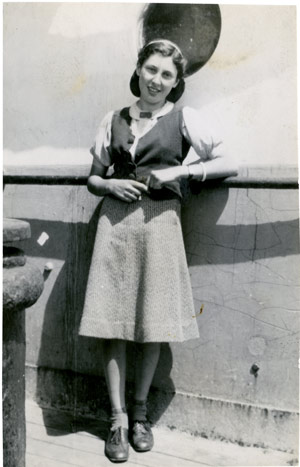 Hannelore on the ship Mouzinho, June 1941
 Julius Alexander’s passport
|
|
/ 1941 /
March 25, the family receives an emigration quota number from the American Consulate in Luxembourg. Soon after, the Nazis close the American consulate in Luxembourg. With the help of a Jewish organization lead by a local rabbi, Hannelore’s family is able to join a small group of Jews traveling to the American Consulate in Belgium, where Hannelore’s parents receive their final papers. Because Hannelore can speak some French, she becomes the group’s interpreter. Her father is responsible for everyone’s luggage.
In late May, the group travels by bus to Metz, France, where they board a train to Paris. From Paris they travel by train to Hendaye, France, from Hendaye to Irun, Spain, then to Villa Formosa (Villa Vermosa), Portugal, to Pampelmosa, Portugal, and finally to Lisbon, where they arrive on June 2. On June 10, they board the ship Mouzinho, which sails from Lisbon to New York, arriving in New York on June 21. Hannelore later writes of this experience:
"In Lisbon we were assigned a room with board where we could wait out the week it would take for the ship to sail. Everyone believed of course that all could go wrong until the very last, this country too could be invaded, America could not want another ship of Jews, or mines in the ocean could blow up the ship. When the day of embarkation came, other Jews in our position also awaiting a boat, accompanied us to the pier, where we parted from them with encouraging words."
Shortly after arriving in the United States, she begins to learn English. She adds to the description of her voyage in a language exercise:
"On our ticket was marked that we had four cabins, but when we came into the ship we just couldn’t get them, the ship was overcrowded and we had third class tickets and had to sleep with a few hundred other people in one big room. The first day my mother and I were very seasick and all four of us slept on deck. In the morning we were very dirty and had only little space to wash. We did that for 3 days, then my mother and Hans slept in their beds and my father and me on a couch. We had to keep our eye on the couch for the evening or somebody else would lie down on it. The food was no good and the room where they served it even worse. I went always with one of the machinists, he was very nice. We talked French together. We were on the ship for 14 days and did I love these days even though we had to live in dirt. Then we came to the USA."
|
|
|
|
Arrival in America
|
 letter, September 1941
|
|
/ 1941 /
Upon arriving in New York, the family stays first with Hannelore’s uncle Siegfried, a doctor, and her aunt at 2871 Heath Avenue in the Bronx. Her uncle, who has paid for their boat tickets, is there to meet them at the dock. He finds them an apartment nearby at 2820 Bailey Avenue in the Kingsbridge section of the Bronx, a middle-class, largely Jewish neighborhood of five-story apartment buildings and brick houses. Hannelore lives at this address until her marriage in 1950. With Siegfried and Hannelore’s help, her father finds work as a dishwasher, then as a carpenter. Her mother works in an orphanage, sewing, and later in the kitchen of Montefiore Hospital in the Bronx.
July 14, Max Ernst and Peggy Guggenheim arrive in New York by steamship from Lisbon. Their arrival signals that the center of gravity in the world of modern art has shifted from Paris to New York.
September 8, Hannelore’s parents send her to enroll herself in the Straubenmuller Textile High School (later renamed Bayard Rustin High School) at 351 West 18th Street, Manhattan, with the following note:
"Dear Principal,
Please accept my daughter Hannelore Alexander, 2820 Baily [sic] Ave., N.Y.C., in your High School. We immigrated to the United States on July 21, 1941. Please excuse me for not being with her. I am employed and cannot get off. My daughter has abilities in drawing and likes to become a designer.
Respectfully,
Jul. Alexander
"
In correspondence with a Dutch magazine writer in 1982, Hannelore writes that her high school training, which centered primarily on fashion illustration, was of no interest to her and of no use in her own art. Nevertheless, materials and textiles, important in the high school curriculum, would become central to her work throughout her career.
December 7, Japan attacks Pearl Harbor. December 8, the United States declares war on Japan. December 11, United States declares war on Germany.
|
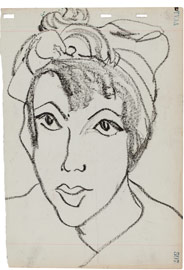 self portrait |
|
/ 1942 /
Hannelore spends much of her time reading and begins to keep a journal in which she enters the author, title and annotations for each book she reads until at least 1951. More than a third of the approximately 350 titles concern China, India, the philosophies of Buddhism, Hinduism, Taoism and Zen, as well as other aspects of the Far East. In a 1981 interview with her son, Mark Baron, Hannelore would recall:
"What I was looking for was some kind of an answer to what everything is all about ... I hadn’t formed the questions, but … I lived in very limiting surroundings, I didn’t have anyone at all around me in the family, or anywhere, that was at all intellectual or at all knowledgeable about anything except the bare everyday existence. I somehow must have guessed or known that there was a whole other thing besides all of this everyday thing… if I had stayed in Germany, I might have never thought of anything but, going through these different countries…when we came to America I didn’t want to get off the boat because somehow I had liked, despite this awful thing in Germany, I did like the new experiences and the going from one thing to another, and I did to a certain extent like the uncertainty, and so when we came here, and I was sort of settled, I continued on my own to travel, only the way I traveled then was through books."
The interview rehearses themes that are key to Hannelore’s narrative of her creative life, including its isolation, autodidactic origins and penchant for symbolism.
June 25, Marcel Duchamp arrives in New York from Paris.
|
| |
|
/ 1944 /
June 6, D-Day landings take place on the coast of Normandy.
|
| |
|
/ 1945 /
May 7, Germany signs unconditional surrender. May 8, V-E Day, announcing the end of the war in Europe.
In June, Hannelore graduates from Straubenmuller Textile High School with a diploma for the “technical course of four years in applied design.”
Hannelore makes representational pencil drawings from life and paints with oils on canvas board. She begins a series of landscape paintings in casein on heavy paper, which gradually become abstract. Her colors become muted, primarily grays, gray-blues, browns and other earth tones, with black. Throughout this time she has little direct contact with art and none with the large emigrant art community in New York.
August 6, the United States drops an atom bomb on the city of Hiroshima, Japan and, on August 9, a second bomb on Nagasaki, Japan.
|
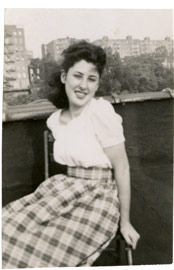 The Bronx, 1946
|
|
/ 1946 /
Hannelore takes a job in Hearns department store at Fourteenth Street and Fifth Avenue in Manhattan as part of “the flying squad,” which fills in for anyone absent from work. At some point while working at Hearns, Hannelore experiences for the first time episodes of intense claustrophobia, which will plague her for the rest of her life. This heralds her first nervous breakdown. She continues to paint and draw sporadically. She later writes of this period:
"At this point, four years after our arrival, I had what might be called a nervous breakdown, anxiety, depression and claustrophobia were the symptoms. Naturally this brought the attention of my uncle Siegfreid. He gave me some sedatives, even took me to some psychiatrists (that did not help the situation a bit), bought me two dresses and told me above all to keep my state of mind an absolute secret from the outside world. I understood the reason for this to be that no one but me ever had any fears and depression like mine and I would be thought somewhat demented if anyone found out."
|
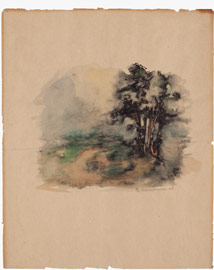
|
|
/ 1947 /
On Easter Sunday, in April, while making pencil sketches in Van Cortland Park in the Bronx, Hannelore meets Herman Baradinsky. He admires her drawings and starts a conversation with her. When he mentions the work of the impressionist painters, who also worked outdoors, Hannelore tells him “I can’t tell you how nice it is to talk with someone who knows these names.”
Herman Baradinsky (he legally changes his name to Baron during the 1950’s) was born in Yonkers, New York, on January 1913, the youngest of six children. By the time Herman meets Hannelore, he has developed a strong interest in classic and modern literature, art and music. His brother, Oscar, runs the Alicat Bookshop and publishes chapbook editions of avant-garde writers, including William Carlos Williams, Anais Nin, Kenneth Patchen and Maya Deren. Herman works as a traveling salesman for the Philosophical Library, which publishes such writers as Jean-Paul Sartre and Albert Einstein.
In October, Hannelore, still suffering from claustrophobia and anxiety, begins three months of psychoanalysis.
Hannelore receives her certificate of naturalization on November 20 and becomes a U.S. citizen.
Hannelore paints semi-abstract works in casein on heavy paper, based on the idea of still lifes and landscapes. Because of her anxiety and claustrophobia, she is unable to travel around the city and has no contact with art. She cannot visit museums, exhibitions or galleries. What she knows of work being done by her contemporaries comes through magazines.
|
| |
|
/ 1949 /
Herman Baron opens Baron’s Bookshop, a small store selling new and used books, at 5997 Broadway in the Bronx.
By the late 1940’s, New York has become the global center for modern art, home to artists such as Piet Mondrian, Arshile Gorky, Jackson Pollock and Mark Rothko, and to influential dealers including Samuel Kootz and Betty Parsons. Robert Rauschenberg studies painting at the Art Students League, Louise Bourgeois has her first solo exhibition of sculpture at Peridot Gallery and Joseph Cornell exhibits his delicate box constructions at the Charles Egan Gallery.
|
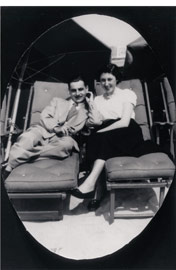 Hannelore and Herman on their honeymoon, Atlantic City, 1950
|
|
/ 1950 /
In a simple civil ceremony, Hannelore and Herman are married on April 16, 1950. They spend their honeymoon in Atlantic City, New Jersey.
Hannelore and Herman move into an apartment on Spuyten Duyvil Parkway in the Bronx. In late 1950 or early 1951, they move to an apartment at 215 West 242 Street in the Kingsbridge section of the Bronx, around the corner from Baron’s Bookshop. They will live here for the next thirteen years.
|

|
|
/ 1951 /
Hannelore paints abstract paintings in casein on heavy paper in grays and browns, based on the idea of aerial views. Her work is exhibited in a summer group show at Creative Gallery, New York, and she becomes a member of the Bronx Artists Guild.
|
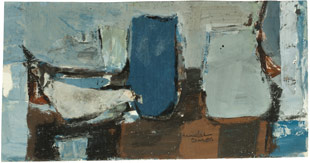 |
|
/ 1952 /
January 12, Hannelore and Herman’s first child, a daughter, Julie, is born.
Herman Baron is acquainted with John Heliker, a landscape painter whose work shows a strong abstract tendency. Heliker, who teaches painting at Columbia University, is a close friend of Oscar Baron and of the painter Arshile Gorky. Every three or four months during the mid 1950’s, Herman and Hannelore bring Hannelore’s work to Heliker for a critique. Baron sees an exhibition of Heliker’s work, and this encounter proves decisive. It suggests to her a way of working that immediately leads to an entirely new approach combining painting and found materials. She would later describe the experience in a 1981 interview with her son:
"I saw Heliker’s show and in his show he had collages combined with paintings. You see, I found it easy to do that. I had thought until then, I don’t know why I thought that, that collage was a thing in itself and it wasn’t combined with painting."
March, de Kooning’s “woman” paintings are shown for the first time in “Willem de Kooning: Paintings on the Theme of the Woman” at the Sidney Janis Gallery.
December, Harold Rosenberg introduces the term Action Painting in an article in Artnews magazine.
|
| |
|
/ 1954 /
Robert Rauschenberg makes his first “combines,” art objects that combine painting and found objects.
|
| |
|
/ 1955 /
January, Cy Twombly's first New York one-person exhibition opens at Stable Gallery. In the same year, the Charles Egan gallery shows one of Robert Rauschenberg's earliest and most controversial combine paintings, Bed, created by dripping red paint across a quilt. Joseph Cornell continues his exploration of box constructions, which include collage, painting and found objects, in an exhibition also at the Stable Gallery.
|
| |
|
/ 1956 /
February 3, Hannelore and Herman’s second child, Mark, is born.
Throughout this period, Baron is increasingly occupied with childrearing. She manages to work at her art in the evenings, after her children are in bed. Later she works when the children are in school. She thinks of her work as “secondary” and “something to do when there was nothing else that was pressing.”
August, Hannelore’s father dies of heart failure.
|
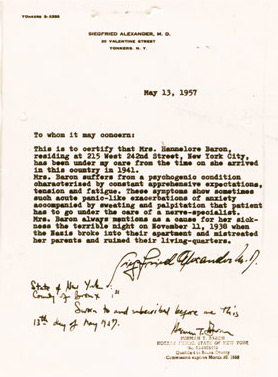 letter, May 1957
|
|
/ 1957 /
Hannelore’s uncle, Dr. Siegfried Alexander, writes a letter to the German government, requesting reparation money for Hannelore as a victim of the war and Nazi persecution:
To whom it may concern:
This is to certify that Mrs. Hannelore Baron, residing at 215 West 242nd Street, New York City, has been under my care from the time on she arrived in this country in 1941.
Ms. Baron suffers from a psychogenic condition characterized by constant apprehensive expectations, tension and fatigue. These symptoms show sometimes such acute panic-like exacerbations of anxiety accompanied by sweating and palpitation that patient has to go under the care of a nerve-specialist.
Mrs. Baron always mentions as a cause for her sickness the terrible night on November 11, 1938 when the Nazis broke into their apartment and mistreated her parents and ruined their living-quarters.
|
| |
|
/ 1958 /
Baron’s work is exhibited in the Art Directions Gallery, New York. She has not seen either Cornell’s or Rauschenberg’s work in person although she appreciates work by Cornell, Franz Kline, Matisse and Klee and is aware of the main currents of art in New York. She is fascinated by work she sees at the Metropolitan Museum and the Brooklyn Museum, when she is able to visit them: Native American, African and Tantric art, as well as ancient textiles. All of these become significant influences on her work.
|
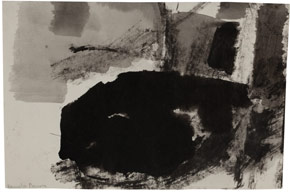
|
|
/ 1959 /
Hannelore’s work is included in ACA Gallery’s Twenty-Third Annual Competition for a First New York Show, June 23- July 3.
Hannelore makes collages with torn paper and casein.
During the next several years, Hannelore Baron’s works are included in annual exhibitions of the Yonkers Art Association (which take place at the Hudson River Museum), the National Association of Women Artists, the National Society of Painters in Casein (at the Riverside Museum) and the Audubon Artists. Her works are also shown at the Croquis Gallery on 56th Street in New York. With two exceptions, she never attends the openings of her exhibitions.
|
| |
|
/ 1961 /
Hannelore likely pays her first visit to Lefebre Gallery for an exhibition of paintings by Julius Bissier, an artist whose influence she absorbs. At the gallery she is equally attracted to work by the eccentric artist Anton Heyboer, with whose drawing style she shares a strong affinity.
|
| |
|
/ 1962 /
Hannelore begins to receive reparation money from the German government. Initial payments of thirty-five dollars a month gradually increase so that by the time of her death in 1987 she is receiving approximately two hundred and eighty dollars a month.
In a letter to the German government posted later, Hannelore answers the following questions in connection with an application for compensation:
Which complaints do you think result from the persecution measures?
My complaints are a nervous breakdown and constant nervousness. This manifests itself as mental restlessness, anxiety, sleeplessness, heart pounding, feeling of faintness, constriction in the throat (a feeling of suffocation), anxiety in closed spaces (moving vehicles such as subway cars, automobiles, elevators, etc.). I am always very worried, even concerning minor things.
It is not possible for me to take employment as I feel very un-independent and have no self-confidence. Besides, it is not possible for me to use any type of transportation by myself to go anywhere. I am often very impatient and nervous with my children, sometimes these feeling are so strong that it is impossible for me to take care of them by myself.
|
| |
|
/ 1963 /
The family moves to 6300 Riverdale Avenue. Tree-lined streets and wooded areas along the Hudson River give Riverdale a small-town suburban atmosphere. Unable to afford a three-bedroom apartment, the family rents a two-bedroom apartment. Julie, age 11, and Mark, age 7, have separate bedrooms, and Hannelore and Herman sleep in the apartment’s living room. Hannelore makes her collages on an old wood desk in the living room. During her entire career, she works in her house and for most of it without the benefit of a formal studio. Like the work of another great collage artist, Hannah Hoch, the scale of her work could be described as domestic.
Hannelore’s work is exhibited at the Croquis Gallery on 56th Street, New York.
November 22, President John F. Kennedy is assassinated in Dallas.
|
| |
|
/ 1964 /
Hannelore makes collages with found paper, ink and watercolor.
|
| |
|
/ 1965 /
Hannelore becomes interested in Italy and Italian culture and begins to study the Italian language, primarily by listening to an Italian radio station. She continues to work on her art albeit sporadically.
|
| |
|
/ 1966 /
Hannelore suffers her second nervous breakdown and begins psychoanalysis at the Psychiatric Clinic of the Jewish Memorial Hospital. When her mental state worsens and she begins to express a desire for self-destruction, she moves to the care of a private psychiatrist, Dr. Hilbert W. Ehrlich. Dr. Ehrlich writes a letter to the German government in November requesting a reimbursement of his fees:
"This is to certify that the above named patient has been seen by me on a regular weekly basis since 9/5/66. At the time she was initially seen she exhibited evidences of an intense anxiety reaction triggered off by her inability to remain at home alone. At that time her children were returning to school after the summer vacation and this in turn caused her to become anxious, depressed and somewhat confused. At the time she was seen there was definite evidence of an impairment of insight and judgment. It was also evident from observation in history that this reaction has been going on for some time with occasional periods of remission alternating with periods of resurgence of the aforementioned intense anxiety reaction. At the time this patient was seen it was on an emergency basis with the situation an extremely severe one. Mrs. Baron has mentioned to me that the normal procedure for reimbursement of medical expenses by the German Government is for her to receive permission but it can be readily seen from the above description of her condition that this was impossible. I have been seeing her on a regular basis since that time and it is my feeling that treatment may have to continue for at least another year on a once weekly basis. I might also mention at the time she was originally seen (Sept. 5, 1966) that she had made suicidal threats and gestures indicating that she would throw herself from her apartment window. I feel that therapy is urgently needed here. My diagnosis at this time is a psychoneurosis anxiety state severe."
|
| |
|
/ 1967 /
Hannelore continues psychoanalysis with Dr. Antonino L. Pesce in Yonkers, New York. She makes small collages of torn paper, with watercolor and delicate drawing in ink.
Hannelore becomes a member of the National Association of Women Artists.
April, anti-Vietnam War demonstrations are held throughout the United States.
October, anti-war demonstrators march on the Pentagon.
|
| |
|
/ 1968 /
On January 2, after a five-month break, Hannelore again begins psychoanalysis, which she continues over the next eight months. She is deeply affected by events in the world, including the war in Vietnam, the hippie phenomenon, environmental catastrophes and natural disasters. She cuts out photographs in magazines for inspiration.
Hannelore works as a volunteer, teaching an arts and crafts class for children once a week at the Yonkers Jewish Community Center. Here she has access to wood and woodworking tools, including an electric jigsaw. One day, when no children show up for one of her classes, Hannelore makes her first wood assemblage. This is followed by assemblages made from found pieces of wood or from weathered wood collected at the beach. She also works as a volunteer teaching an art class at the local elementary school PS 81.
Hannelore joins the Artists Equity Association of New York.
March 16, U.S. soldiers of the Charlie Company, 11th Brigade, enter the village of My Lai in Vietnam and massacre two hundred civilians.
April 4, Martin Luther King is assassinated.
June 6, Robert F. Kennedy is assassinated.
|
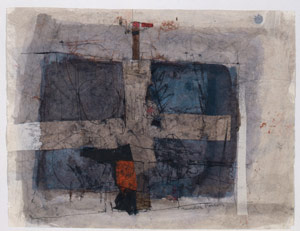 untitled, 1969
|
|
/ 1969 /
Hannelore makes collages with crumpled paper and constructs box assemblages from found wood, driftwood and wire. The collages are at once delicate and crude, combining swatches of color organized along roughly geometric lines with spidery drawing of quasi-symbolic shapes and signs.
Hannelore has a one-person exhibition at Ulster County Community College, Stone Ridge, New York, and her work is purchased by the college.
The Tyndall Creek Gallery, a small storefront gallery founded by David Beecher, opens in Riverdale. When Hannelore visits the gallery out of curiosity, she is offered the job of director. This lasts for the several months the gallery is open, during which time she shows her own work and the work of her friend, the abstract painter Alvin Most.
August 15-17, approximately 500,000 young people come to Bethel, New York to attend the Woodstock Festival for “three days of peace and music.”
|
| |
|
/ 1970 /
In 1970, the family receives a small inheritance after the death of Murray Baron, Herman Baron’s brother.
This enables them to purchase a private house at 2675 Delafield Avenue, also in the Riverdale section of the Bronx. Baron sets up a studio for the first time in a small room on the second floor of the house.
In a 1982 letter, she writes:
"My studio is very simple. I like the old and used, with a past, and it is with that feeling I furnished my studio. It contains two desks, one of metal on which I work and another wooden one, some chests with drawers for the collages and an etching press which I use in my own fashion."
Hannelore makes a series of collages with the theme of torn flags. It is a theme she will return to frequently in both collages and box constructions, and it illustrates her continuing sensitivity to political and social events, which, she later insists, provide inspiration for much of the ambiguous symbolism of her works.
Hannelore does volunteer work as an occupational therapist at Parkview Nursing Home, 6585 Broadway in the Bronx until 1973.
May, Eva Hesse, like Hannelore an émigré German artist, dies of cancer at age thirty four. Of all Hannelore’s contemporaries, Hesse’s imaginative independence and her deep connection to childhood are closest in spirit to Hannelore’s own character, although the two artists never meet. Likewise Hesse’s tragic struggle with cancer presages Hannelore’s own, which begins just two years later.
|
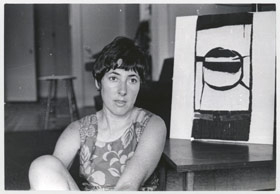 circa 1971 |
|
/ 1972 /
Hannelore makes large cloth collages, most of which she will destroy several years later, and small collages with watercolor on canvas.
In December the Hudson River Museum purchases the collage Flag.
Hannelore now speaks Italian fluently and becomes immersed in Italian literature, music, movies and cooking. As part of her obsession, she develops an interest in Catholicism and chooses St. Anthony as her patron Saint. The idea of her changing her cultural identity by replacing it with another amuses Hannelore, especially given the absurdity of her adopting the culture of a country she has never visited. She says repeatedly that she does not believe in “organized religion,” meaning religious beliefs that are not personally developed by the believer but rather accepted as doctrine. She is fascinated by reliquaries, and these containers have a marked influence on her box constructions.
Baron begins volunteer work teaching art to children at the Riverdale Neighborhood House.
December, Joseph Cornell dies. Like Hannelore, the artist has spent his entire creative life working in a medium he creates, in the same domestic location, his house in Queens, New York.
|
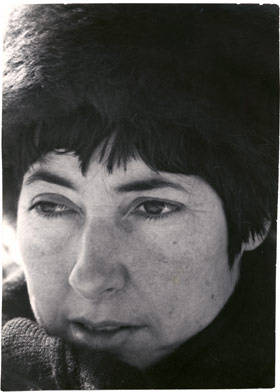 circa 1973
|
|
/ 1973 /
Hannelore is diagnosed with breast cancer, which is found in one breast and in the lymph nodes under her arm. A mastectomy is performed, and she begins a period of chemotherapy.
Hannelore suffers her third nervous breakdown, and she resumes psychoanalysis.
Hannelore is one of six artists selected for an exhibition at the Hudson River Museum in Yonkers, entitled 6 solos (March 11 - April 22). Each artist is given a separate room. She exhibits twenty-five works, including fifteen collages, six watercolors and four works described as Etching (mixed media). She develops a distinctive etching technique. Her personal statement in the catalogue reads:
"Some of my collages celebrate events long past, and others, especially the cloth banners, commemorate feelings or moods. There are those I would hang up on joyful occasions and others on mourning days. Generally I work small, because that is how I feel, here in the New York…and confronted with exploration of the vastness of outer space."
|
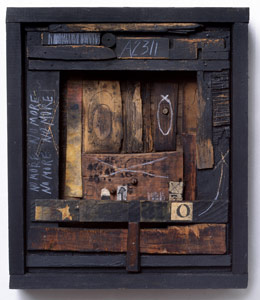 Box, 1975
|
|
/ 1975 /
Hannelore makes collages with the themes of war letters, children’s letters and envelopes. She also constructs boxes with the themes of religious shrines, children’s games and protests against war, including the mixed media box entitled No More, No More. Unlike the boxes of Joseph Cornell, which invite viewers to peer into a personal and idiosyncratic universe, Hannelore’s boxes are damaged, sealed and forbidding, their exact contents unknowable.
In a local class, Hannelore learns how to make stained glass.
Several works are consigned to the Allan Stone Gallery, New York
Hannelore’s work is in the exhibition “Celebration: Women in the Arts” at the Ulster County Community College in Stone Ridge, New York.
|
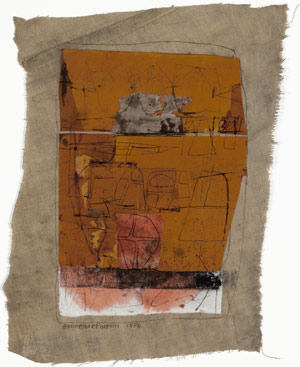
|
|
/ 1976 /
Hannelore develops a technique for making monoprints by cutting thin sheets of copper with scissors in the shapes of heads, figures or birds. She then inks both sides of the small copper forms with a roller or by applying ink with her fingers. These cutout forms are then printed with a small etching press. By placing the inked copper forms between two sheets of rice paper, she produces two prints, mirror images, in one run through the press. Variations are made by wrapping the forms with inked pieces of cloth or with string. The monoprints are usually incorporated into collage works.
In a 1981 interview with her son, Hannelore describes the process, its significance and the source of some of her work’s symbolism:
"There are limited things I could do with the cut out figure and wrapping it up was one of them. Besides that I was always interested in Egyptian mummies, and sometimes certain things I see before I do them and certain things after that relate to the work I’m doing. In other words, I very often like to see something afterwards that relates to the work and gives it more meaning. A meaning that I really didn’t have in mind when I started but that applies to it in retrospect. So I started out thinking of the mummies and certain American Indian burial costumes, other things that were found in remote areas, archeological finds, but later on during the Vietnam War when I saw all these bodies in plastic bags...Vietnamese women sitting there crying with their husbands lying next to them in the bag...then I thought of that whole thing too. Like the burial at sea, where they throw the body off the boat in a bag and so on...as I was doing them I somehow related what I was doing to all of that....The string does have to do with imprisonment. You see, a lot of the work is done totally on a subconscious level and then I try to think up later why I might have done that and I can’t really tell how much of it is subconscious and how much of it is consciously….I am very concerned about political prisoners all over the world, and of course it has to do with my own past experiences where I was not tied up, but it does not mean literally physically tied up. As I’ve experienced for myself, you can be in prison without being in a locked room. You are imprisoned by your own fears, inhibitions, phobias. It’s the same effect as if you’re tied up with ropes, so it isn’t always a literal meaning."
Hannelore’s son, Mark, asks her if he can bring a selection of her collages to galleries, and Hannelore agrees. The Kathryn Markel Gallery asks to keep, on consignment, several collages.
|
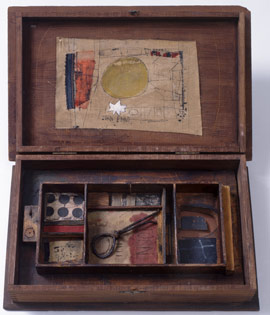 Torn Flag, 1977
|
|
/ 1977 /
May 10, Hannelore Baron’s first exhibition at Kathryn Markel Gallery opens.
The Hudson River Museum purchases a second collage.
In September, Hannelore is represented in the exhibition, “The Hudson River Open,” at the Hudson River Museum, Yonkers, New York. Her work begins to incorporate the human figure more frequently, either drawn or in monoprint, often rendered armless and apparently screaming.
At the suggestion of her friend Dolly Komar, Hannelore begins sessions with psychologist Hugo G. Beigel. Later Hannelore recalls:
"[Hugo Beigel] was the only one who spoke to me as if I was on his level. All the others talked down to me, never explained to me what the problem was, never explained to me that there were other people who have my same symptoms or anything at all. All the time I felt as if there was something wrong with me and I didn’t know what it was and I thought that I was different from all the other people, that there was no other person that had what I had. I didn’t know how I got it. I didn’t know how I’d get rid of it and I didn’t know if I got rid of it, if I’d get it again. I just didn’t understand it. I had no idea and so I believed that none of the psychiatrists were good because none of them explained to me what was going on."
|

|
|
/ 1978 /
Cancer is found in one lung and surgery is performed to remove two thirds of the affected lung. During the time Hannelore spends recuperating in New York Hospital, she completes seventeen drawings. After her release she begins three years of chemotherapy.
Hannelore makes cloth and paper collages with monoprints.
The National Museum of American Art (Smithsonian Institution) purchases a collage from the Kathryn Markel Gallery and exhibits it the same year in a show titled New Acquisitions.
Hannelore begins to use bird images in her collages and boxes. Some birds, printed as monoprints from cut copper forms, have string wound around their legs or bodies. Others, drawn by Hannelore as transfer drawings, appear within boxes that tightly confine them. She writes:
The birds come out of my concern for the ecology and symbolize the small and defenseless that will be crushed in the rush toward ever greater material comfort and deadlier wars.
March 16, the Amoco Cadiz runs aground polluting 240 miles of Brittany’s coast with 223,000 tons of crude oil. It is the first major oil spill to be covered by the world’s media in real time. Images of seabirds struggling in their coating of oil appear in magazines and on televised news.
|
| |
|
/ 1979 /
Hannelore begins to make “transfer drawings,” using a technique similar to that used by Paul Klee in the early 1920’s. These drawings are made by rolling ink onto a small piece of slate or glass and placing
rice paper on the inked surface, then drawing with a pencil or ballpoint pen.
|
| |
|
/ 1980 /
Hannelore works on large collages on rice paper with transfer drawings, assemblages within small hinged metal boxes and white painted boxes with monoprints and ink. For a significant period in 1980, the artist stops working altogether and is deeply distressed by her inability to work. According to her husband, she begins again after an incident in which he attempts to make a collage with her help. Unhappy with the decisions he is making, she takes over the process.
Hannelore’s son Mark moves out of the house in Riverdale in August, and the artist takes over his two small attic rooms as her studio.
|
| |
|
/ 1981 /
Three years of chemotherapy are over.
In January, the Albright-Knox Member’s Gallery in Buffalo, New York, mounts a one-person exhibition of the artist’s work.
Hannelore makes small collages on rice paper with ink washes and transfer drawings and constructs boxes with paint, transfer drawings, clot, and string. Mark Baron brings several collages to Gallery Schlesinger-Boisanté in Manhattan. The gallery expresses an interest in showing the work.
April 7 to May 2 marks the final exhibition at Kathryn Markel Gallery.
From November 24 to December 24, Gallery Schlesinger-Boisanté mounts its first exhibition of the work.
|
| |
|
/ 1982 /
In May, cancer is found in Hannelore’s ovaries, and a hysterectomy is performed. Baron begins a prescribed year of chemotherapy treatment.
Gallery Schlesinger-Boisanté arranges a Hannelore Baron exhibition in Dillingen, Germany, the artist’s hometown, at the Kunstverein Galerie im Rathaus, Dillingen. For this exhibition, Hannelore writes a one-page text and also constructs a box that includes her father’s passport, stamped with a large red J (designating Jew), and other German documents. According to her instructions, the text and box are separated from the rest of the exhibition and are hung in a hall outside the exhibition space. Because of the special circumstances of this exhibit, Hannelore allows a text of this sort to be made public. The Kunstverein invites her to attend the exhibition.
From May 8 to June 19, the Roger Ramsay Gallery in Chicago exhibits the artist’s work. When the exhibition opens Hannelore discovers that the text she wrote for the Dillingen exhibition describing the traumatic events of her childhood has been printed on an announcement card. Deeply upset, she writes to Roger Ramsay:
What I was not prepared for was the biographical note on my childhood in back of the card. It was written by me and presents the facts as they were, but was meant only for a show this summer in Germany at the locale where the events occurred.…There have been so many who have had to suffer through wars and tortures on a massive scale in the years since the 1940’s that it seems redundant to remind people of what can be recognized now as just an early evidence of man’s capacity for evil in the contemporary world. Also, I am a strong believer in not mixing the artist’s private and professional life if possible.
On September 16, at the urging of her dealer Steve Schlesinger and his wife Vera, Hannelore decides to follow a macrobiotic diet under the guidance of a specialist, Ms. Shizuko Yamamoto. The following month, Hannelore decides to discontinue her chemotherapy treatments; the injection of toxins is in conflict with the basic principles of a macrobiotic diet. At this point Hannelore has undergone half of the twelve-month period of treatment prescribed by her oncologist.
November 12 to December 5, a solo exhibition is mounted in Saarbrucken Germany at the Moderne Galerie des Saarland-Museums, Studiogalerie.
In November, Hannelore responds to the invitation to come to Dillingen with the following letter, written in German:
Nov. 24, 1982
Dear Mrs. Dr. Peter
Thank you for your letter suggesting that I might come to Dillingen for an exhibition of my pictures. Unfortunately, such a visit would be out of the question for me. After I left Germany and lived in America for four years, I began to suffer with my nerves. I had frequent anxiety attacks and depression, which were very difficult to deal with. Therefore, it would pose a great risk for me to go to Germany, where everything would constantly be reminding me of earlier times.
From my point of view, regarding what has occurred, I can only say that I am very pessimistic about humanity in general. If you would say that such things should not repeat themselves, I can only answer that, in my view, they already have. That which happened a few weeks ago in Lebanon, what happened in Vietnam and the possibility of the neutron bomb shows, in my view, the same indifference for human life.
That is why, when you ask for an explanation for my pictures, I say that for many years I have protested, hoping for justice, but now they are memorials for the unfortunate ones who must suffer.
However, I would like to add that the exhibition, in what used to be my home, personally has a great deal of meaning for me, and that insofar as it is possible for me to return home I feel it is a symbolic return.
With best wishes and greetings,
Hannelore Baron
Please excuse any writing errors, and should you have any other questions please feel free to write to me, anytime.
|
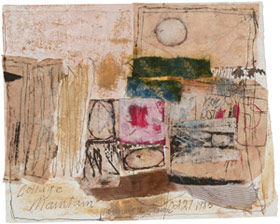 untitled, 1983
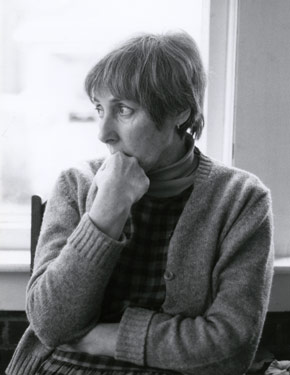 mid 1980’s
|
|
/ 1983 /
By June, Hannelore decides to end her macrobiotic diet, but at this point she is no longer able to eat anything. Disillusioned, she writes:
There was the movie Betrayal, showing a love affair backwards, with the lovers meeting some years after the end of their relationship. I could start this account from that direction, with the facts that I lost about 35 pounds, my bones stick out so I am uncomfortable in bed, where I spent most of my time lately. But I’ll go back to the beginning of my involvement with Macrobiotics and how it took over my life and reduced me to what I am now. There will be the facts without a clear conclusion, because I just don’t know enough even at this stage to totally condemn the macrobiotic regime. All I can write about is what happened to me, with my particular personality and make up and background.
Cancer is found below her liver, and Hannelore once again begins chemotherapy.
Fighting depression during October and November, Hannelore experiences a burst of creativity. She makes a series of approximately twenty extraordinary collages, among her most poignant works. Some are very sparse, with pastel colors and gold oil-pastel. For these works, she revisits the landscapes and still lifes of her first collages in the late 1950’s. For the first time in ten years (since collages such as Spring Letter and War Letter of 1973), Hannelore titles the works. She writes titles and dates and signs them on the front, also an exceptional practice for her. Inscriptions on these works include: the very first of the hurtful collage mountains, the hurtful collage mountains; and Collage mountain, Hannelore Baron, Oct 27 1983.
During this time, Hannelore’s daughter often brings her children, Tara and Evan, to stay with her for weekends. Hannelore entertains her grandchildren with arts and crafts projects and invented games and theater. She also writes stories for them. Although the following story (found among her papers) is written in the style of a children’s story, its content suggests Hannelore wrote it for herself.
The bear who had to solve his own problems.
Once there was a toy bear. Most of the time he just sat on the bed and day dreamed or hibernated, until he developed some small problems that got bigger with time. He began to long for the woods and the other bears and a family. He no longer wanted to wear the sweatshirt someone had put on him. He wondered what his native language was and if he would ever be able to get off the bed he was always sitting on. One day in his rebellion, he made a little puddle on the bed, but no one cared and afterwards it just smelled bad. Then he got very sad and pulled the sweatshirt hood over his eyes. His tears wet the fur on his stomach and afterwards it was not shiny and smooth anymore. Then to comfort himself, he sucked his finger until it came right off his hand. Now he thought he was so ugly that he crawled under the bed where he got all dusty. The next week the cleaning lady said: Shall we save that smelly old dusty scroungy bear under the bed with his finger missing and his fur all musty? The lady of the house said no, throw him in the garbage. Would it not have been better if someone had tried to help him solve his problems in the beginning and shown some care?
|
| |
|
/ 1984 /
September 5 to October 6, Mark Baron curates an exhibition titled “Selected Drawings by Eleven Artists” at Willard Gallery, New York and includes several of Baron’s works. These works are discussed by Kay Larsen in a lengthy review, “The Cooked and The Raw,” in New York Magazine.
|
| |
|
/ 1985 /
Hannelore works on boxes with red and white striped cloth from old American flags and sparse cloth collages with black diamond shapes.
|
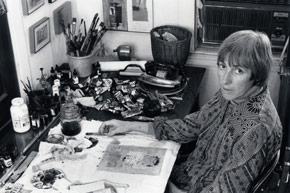 late 1980’s
|
|
/ 1986 /
Increasingly beset by illness, Hannelore makes a series of collages, on paper, with washes of blue ink and luminous colors. In a statement for an exhibition at Gallery Schlesinger-Boisanté, she writes of this series:
"There comes a time when we know that the most colorful part of our life lies behind us. Isak Dinesen knew, when—aged and ill, in the cold climate of Denmark—she wrote loving remembrances of a farm she once had in Africa. Her words evoked strong images for me, and out of those came this series of warm, sunlit landscape collages."
|
 last work, inscribed Der Tod Kommt (Death is Coming), drawn from Baron’s hospital bed, April 1987
|
|
/ 1987 /
Extremely weak, Hannelore enters Columbia Presbyterian Hospital on March 9. Her son brings a sketchpad and some pencils and pens to the hospital so that she can draw. She makes a single pencil drawing from her hospital bed. It is her last work. Among heads, hands, and a lying female figure are the words DER TOD KOMMT (DEATH IS COMING).
Hannelore decides not to undergo treatment for her cancer, and she dies on April 28 at Columbia Presbyterian Hospital. According to her wishes, there is no funeral service. She is cremated on April 30.
|
| |
|
/ 1989 /
May 19 to July 9, Solomon R. Guggenheim Museum, New York, organizes Hannelore Baron. The exhibition consists of fourteen collages and five box assemblages.
|
| |
|
/ 1995 /
October 24 to December 29, Barbara Mathes Gallery in New York presents Hannelore Baron, Collages & Box Constructions. The entire exhibition is purchased on the first day by private collectors Mary Mhoon and James Perry Walker.
|
| |
|
/ 2001 /
October 2 to November 4, exhibition at Herter Art Gallery, University of Massachusetts, Amherst, Hannelore Baron (1926-1987): Selected Works
|
| |
|
/ 2002 /
The first national touring exhibition of her work, Hannelore Baron: Works from 1969 to 1987, is organized by SITES (Smithsonian Institution Traveling Exhibition Services). Curated by Ingrid Schaffner, the exhibition includes thirty seven collages, five box assemblages, and one drawing (Hannelore’s last work). Between February 2002 and August 2004, the exhibition tours to eight venues: Marsh Art Gallery, Richmond, Virginia; the Iris & B. Gerald Cantor Center for Visual Arts, Stanford, California; the Macalester College Art Gallery, St. Paul, Minneapolis; Neuberger Museum of Art, Purchase, New York; Bass Museum of Art, Miami Beach, Florida; Mennello Museum of American Folk Art, Orlando, Florida; George Washington University, Washington, DC; University Art Museum, California State University, Long Beach, California. A fully illustrated catalogue with an essay by Ingrid Schaffner is published.
September 14 to November 2, exhibition at Art Museum of the University of Memphis: Hannelore Baron, Fragments Shored Against Ruins, comprising more than sixty works from the collection of Mary Mhoon and Perry Walker, accompanied by a catalogue.
|